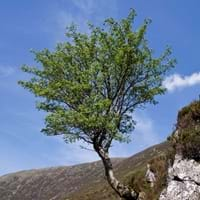Life Span
Annual and Perennial
Perennial
Type
Bulb or Corm or Tuber
Tree
Origin
Central America, South America
Asia, Europe, Northern Africa
Types
Vine, Flowering plant
Sorbus aucuparia fenenkiana, Sorbus aucuparia glabrata, Sorbus aucuparia praemorsa
Habitat
All sorts of environments, Along Railroads, Banks, Moist Ditches, Roadsides, rocky banks of streams
Temperate Regions
USDA Hardiness Zone
10-13
3-7
Sunset Zone
21,22
A1, A2, A3, 1a, 1b, 2a, 2b, 3a, 3b, 4, 5, 6, 7, 8, 9, 10, 14, 15, 16, 17
Habit
Vining/Climbing
Oval or Rounded
Minimum Width
Not Available
Flower Color
Purple, Rose
White
Flower Color Modifier
Bicolor
Bicolor
Fruit Color
Not Available
Orange, Yellow
Leaf Color in Spring
Purple, Dark Green, Black
Green
Leaf Color in Summer
Light Green
Green
Leaf Color in Fall
Several shades of Green
Dark Green
Leaf Color in Winter
Light Green
Dark Green
Leaf Shape
Acicular
Pinnate
Plant Season
Spring, Summer, Fall, Winter
Spring, Fall
Sunlight
Full Sun, Partial Sun
Full Sun, Partial Sun
Growth Rate
Very Fast
Medium
Type of Soil
Clay, Loam, Sand
Clay, Loam, Sand
The pH of Soil
Acidic, Neutral, Alkaline
Acidic, Neutral
Soil Drainage
Well drained
Average
Bloom Time
Late Spring, Early Summer, Summer, Late Summer, Early Fall, Fall, Late Fall
Late Spring
Tolerances
Drought
Not Available
Where to Plant?
Container, Ground
Ground
How to Plant?
Cuttings, Leaf Cutting, Tuber propagation
Budding, Grafting, Stem Cutting
Plant Maintenance
Medium
Medium
Watering Requirements
Keep the Soil well drained, Needs very little water
Do Not over Water, Water in the early morning hours
In Summer
Lots of watering
Lots of watering
In Spring
Moderate
Moderate
In Winter
Average Water
Average Water
Soil pH
Acidic, Neutral, Alkaline
Acidic, Neutral
Soil Type
Clay, Loam, Sand
Clay, Loam, Sand
Soil Drainage Capacity
Well drained
Average
Sun Exposure
Full Sun, Partial Sun
Full Sun, Partial Sun
Pruning
Remove damaged leaves, Remove dead branches, Remove dead leaves
Remove dead or diseased plant parts, Trim each shoot back to the first set of leaves
Fertilizers
All-Purpose Liquid Fertilizer
All-Purpose Liquid Fertilizer, Doesn't require fertilization when grown in rich soil
Pests and Diseases
Red blotch
Aphids, blister mites, Canker, fireblight, sawflies, Silver leaf
Plant Tolerance
Drought
Not Available
Flower Petal Number
Single
Single
Foliage Texture
Coarse
Fine
Foliage Sheen
Matte
Matte
Attracts
Aphids, Beetles, Cutworms, Insects, Mites, Whiteflies
Birds
Allergy
Abdominal pain, allergic reaction, Nausea, Skin rash, Twitching of face
Anxiety, Depression, High blood cholestrol, High blood pressure, Pain, Stress
Aesthetic Uses
Not Used For Aesthetic Purpose
along a porch, deck or patio, Showy Purposes
Beauty Benefits
Not Available
Not Available
Environmental Uses
Air purification
Air purification, Food for birds, Shadow Tree
Medicinal Uses
Cures constipation, Fiber, Low calories, lowering blood pressure, Potassium, ß-carotene, Vitamin A, Vitamin C
Diarrhea, Inflammation, Laxative, Urinary tract problems, Vitamin C
Part of Plant Used
Leaves, Root, Shoots, Stem, Tuber
Bark, Fruits, Wood
Other Uses
Starch, Used As Food, Used as Ornamental plant
Used for its medicinal properties, Used for woodware
Used As Indoor Plant
Sometimes
No
Used As Outdoor Plant
Yes
Yes
Garden Design
Container, Edible, Groundcover, Hanging Basket, Herb / Vegetable, Mixed Border, Rock Garden / Wall, Vine
Feature Plant, Mixed Border, Topiary / Bonsai / Espalier
Botanical Name
IPOMOEA batatas 'Blackie'
Sorbus aucuparia
Common Name
Blackie Sweet Potato Vine, Sweet Potato Vine
Rowan, Mountain ash
In Hindi
शकरकन्द
रोवाण पौधा
In German
Süßkartoffel
Rowan Tree
In French
Patate douce
Rowan Tree
In Spanish
Ipomoea batatas
Rowan Tree
In Greek
Sweet potato
Rowan Tree
In Portuguese
Batata-doce
Árvore de Rowan
In Polish
Wilec ziemniaczany
Rowan Tree
In Latin
Ipomoea batatas
Rowan ligno
Phylum
Tracheophyta
Magnoliophyta
Class
Magnoliopsida
Magnoliopsida
Family
Convolvulaceae
Rosaceae
Clade
Angiosperms, Asterids, Eudicots
Angiosperms, Eudicots, Rosids
Tribe
Not Available
Not Available
Subfamily
Not Available
Not Available
Number of Species
Not Available
Not Available
Season and Care of Sweet Potato Vine and Rowan Tree
Season and care of Sweet Potato Vine and Rowan Tree is important to know. While considering everything about Sweet Potato Vine and Rowan Tree Care, growing season is an essential factor. Sweet Potato Vine season is Spring, Summer, Fall and Winter and Rowan Tree season is Spring, Summer, Fall and Winter. The type of soil for Sweet Potato Vine is Clay, Loam, Sand and for Rowan Tree is Clay, Loam, Sand while the PH of soil for Sweet Potato Vine is Acidic, Neutral, Alkaline and for Rowan Tree is Acidic, Neutral.
Sweet Potato Vine and Rowan Tree Physical Information
Sweet Potato Vine and Rowan Tree physical information is very important for comparison. Sweet Potato Vine height is 15.00 cm and width Not Available whereas Rowan Tree height is 1,000.00 cm and width 800.00 cm. The color specification of Sweet Potato Vine and Rowan Tree are as follows:
Sweet Potato Vine flower color: Purple and Rose
Sweet Potato Vine leaf color: Purple, Dark Green and Black
Rowan Tree flower color: White
- Rowan Tree leaf color: Green
Care of Sweet Potato Vine and Rowan Tree
Care of Sweet Potato Vine and Rowan Tree include pruning, fertilizers, watering etc. Sweet Potato Vine pruning is done Remove damaged leaves, Remove dead branches and Remove dead leaves and Rowan Tree pruning is done Remove dead or diseased plant parts and Trim each shoot back to the first set of leaves. In summer Sweet Potato Vine needs Lots of watering and in winter, it needs Average Water. Whereas, in summer Rowan Tree needs Lots of watering and in winter, it needs Average Water.





